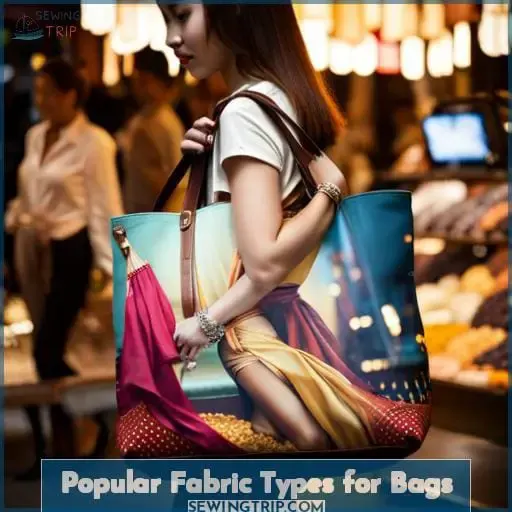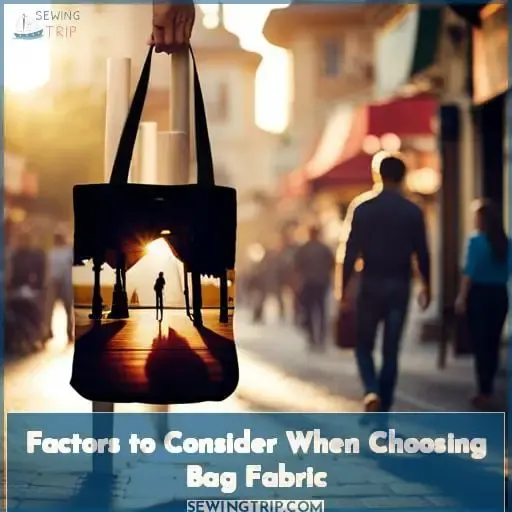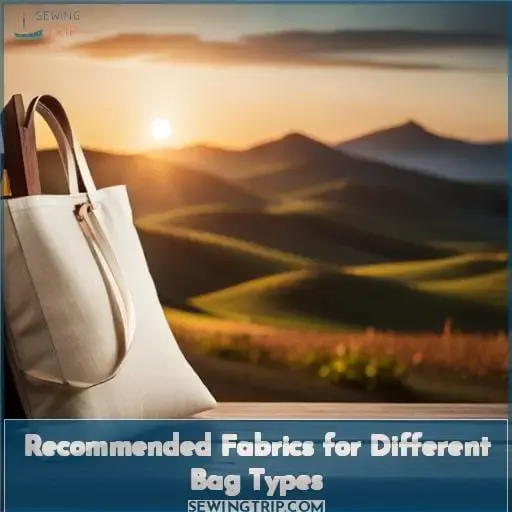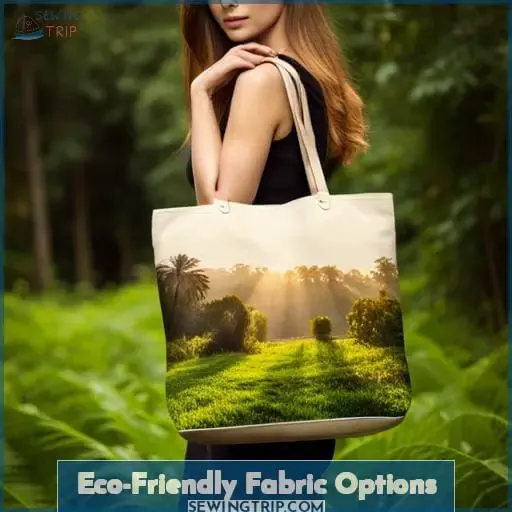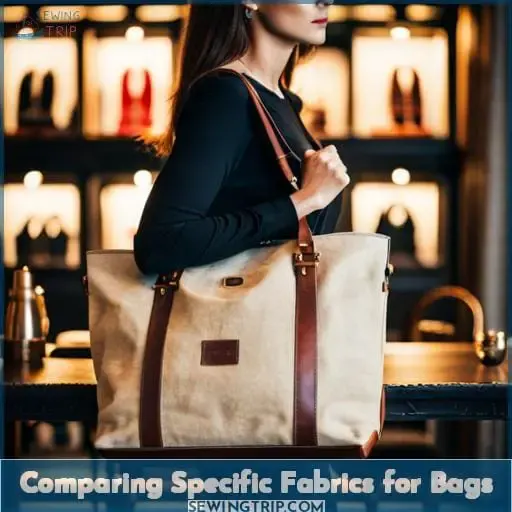This site is supported by our readers. We may earn a commission, at no cost to you, if you purchase through links.
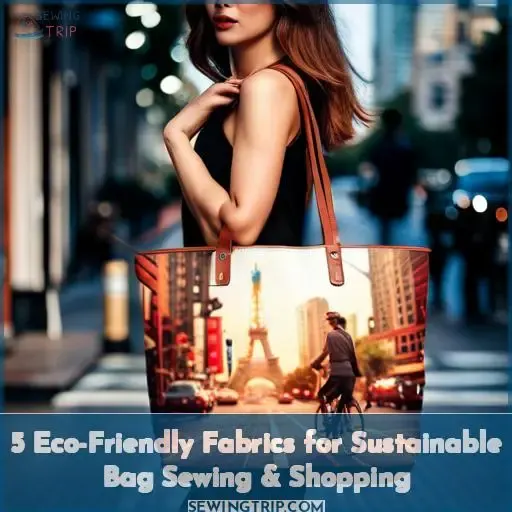 A rainbow of cottons, hemps, and jutes await your deft fingers!
A rainbow of cottons, hemps, and jutes await your deft fingers!
Let your creativity soar as you shape earthy fabrics into totes and satchels with style and purpose.
Each stitch connects you to artisans worldwide.
Feel the textures, trace the grains, as you craft your statement in sustainable fabrics.
Our eco-choices shape lives.
Table Of Contents
Key Takeaways
- Consider weight, durability, style, and function when selecting bag fabrics. Durable canvas and cotton work well for totes; sturdy canvas or leather is best for backpacks.
- Eco-friendly fabrics like organic cotton, hemp, and jute are sustainable, durable options.
- Mix and match fabrics for unique combinations. Pair prints, textures, and colors creatively based on bag type and aesthetic.
- Adjust sewing technique for each fabric type. Use sharp needles, polyester thread, and reinforced seams as needed for heavier fabrics like tweed and leather.
Popular Fabric Types for Bags
When making or shopping for eco-friendly bags, consider using canvas, leather, tweed, or decorator weight fabrics.
These fabric types are durable, eco-friendly, and give bags a stylish look.
Let’s explore some specifics on each of these eco-friendly bag fabrics:
Canvas
With canvas as one of your best material choices for bags, you’ll find it sturdy, inexpensive, and easy to work with.
Canvas is widely available in a variety of colors and patterns.
The medium-weight fabric is ideal for totes and backpacks.
Prewashed canvas softens with use, developing a beautiful patina over time.
Leather
You’ll find leather makes for durable and stylish bags.
Genuine or thrifted leather offers a stylish mix when paired with fabric prints or solids and neon accents.
Consider leather alternatives to follow eco-friendly goals.
Tweed
Tweed delivers depth and richness for handcrafting chic bags.
Affordable tweed alternatives allow mixing regal elegance with other fabrics in fresh, sustainable styles.
Upcycling vintage tweed sustains treasured textures in of-the-moment tweed totes.
Decorator Weight
Decorator weight fabrics offer a wide range of options for bag sewing, including substantial fabrics suitable for upholstery, drapery, and pillow covers. When selecting fabric weight, consider the capabilities of your sewing machine to minimize seam lines in heavier bags.
Prioritize factors such as texture, drape, durability, and print scale to ensure the fabric is appropriate for your project.
Decorator weight fabrics come in a variety of popular types, each with its own unique characteristics. Canvas, a sturdy and durable fabric, is often used for tote bags and backpacks. Duck cloth, a tightly woven fabric with a smooth surface, is also a popular choice for bags.
Denim, a durable and versatile fabric, is a classic choice for jeans and can also be used for bags. Corduroy, a fabric with a distinctive ribbed texture, adds a touch of style to bags.
Factors to Consider When Choosing Bag Fabric
When choosing a fabric for your bag, there are three key factors to consider:
- Weight
- Durability
- Style
What’s the intended use and desired lifespan for this bag? Selecting an eco-friendly fabric with the appropriate weight and durability will ensure your bag serves its purpose in a sustainable way.
The style of the bag should also guide your fabric choice toward colors, patterns, and textures that express your personal flair.
Weight
Consider fabric weight when choosing material for your bag project.
Think about what your bag needs to hold securely, without being cumbersome or too heavy.
Examining what works with your bag’s function allows flexibility to mix and match lighter linings or heavier straps.
Pursuing eco-friendly choices like natural plant fibers or recycled materials produces biodegradable yet durable bags.
Durability
You’ll also want to think about how durable the fabric is for the type of bag you’re making.
Consider how the fabric holds up to abrasion and if it can be finished with sustainable coatings to improve longevity.
Review durability test results and factor in wear resistance along with the bigger environmental impact of the textile over time.
Select fabrics with proven durability that align with your eco-friendly bag-making goals.
Style
Style (Factors to Consider When Choosing Bag Fabric)
You’ll select the style of fabric based on the type of bag and your desired aesthetic.
Color Combinations: Consider the colors that will complement your wardrobe and personal style.
Pattern Pairing: If you’re using a patterned fabric, think about how it will pair with other fabrics in your bag.
Texture Trends: Consider the texture of the fabric. Do you want a smooth, soft fabric, or a more textured fabric with a unique feel?
Strap Styles: The style of the strap will also affect the overall look of your bag. You can choose from a variety of strap styles, including shoulder straps, crossbody straps, and backpack straps.
Recommended Fabrics for Different Bag Types
When making your own bags, the type of bag should influence your fabric choices.
For totes, backpacks, and purses, you’ll want fabrics that are lightweight yet durable, such as cotton, linen, hemp, or recycled polyester.
Consider the bag’s intended use as you select eco-friendly materials that will hold up well.
Totes
You’re looking at canvas and cotton when shopping for eco-friendly tote fabrics.
Mix materials like canvas and strap details in leather for extra style.
Pair prints like floral cotton with solid canvas.
Consider strap length and width.
Size impacts bag function.
Combine colors creatively.
Backpacks
You’d do well selecting durable canvas or leather for your backpack build.
Consider custom embroidery, leather accents, or upcycled designs with DIY embellishments.
Choose sustainable linings and eco-friendly materials like cotton, hemp, jute, or recycled fabric.
Purses
Two lightweight yet durable options for purse fabric include:
- Linen
- Cotton canvas
Embellished bohemian cotton pouches or an upcycled canvas clutch add artistry.
Choosing sustainable textiles like hemp decreases reliance on leather.
Eco-Friendly Fabric Options
When it comes to eco-friendly fabrics, you’ll want to look for natural fibers like organic cotton, hemp, and jute.
These plant-based textiles are biodegradable, renewable, and cultivated using fewer chemicals.
Let’s take a closer look at why these fabrics make excellent sustainable options for sewing or shopping for bags:
- Organic cotton: Grown without the use of pesticides or synthetic fertilizers, organic cotton is a sustainable choice that is gentle on the environment.
- Hemp: A durable and versatile fiber, hemp is naturally resistant to pests and diseases, making it a low-maintenance crop.
- Jute: A strong and affordable natural fiber, jute is often used in the production of burlap and hessian fabrics.
Organic Cotton
Choose organic cotton when seeking an eco-friendly fabric option for your bags:
- Promotes soil health through sustainable farming practices.
- Uses less water than conventional cotton.
- Grown without pesticides or synthetic fertilizers.
Fair trade practices support farmers and families:
- Reduces environmental impact with organic growing methods.
Hemp
With hemp being an extremely durable, rot-resistant natural fiber that requires little water and pesticides to grow, it makes for an excellent eco-friendly fabric choice when making reusable bags.
| Benefit | Description |
|---|
Durability
Sustainability
Strength
Versatility
Renewability
Jute
When comparing jute and polypropylene for reusable bags:
- Jute is the more eco-friendly choice, as it is a natural fiber that is biodegradable and compostable.
- Polypropylene is very durable and recyclable, making it a good choice for bags that will be used frequently.
Here is a 3-item list comparing jute and polypropylene:
- Eco-friendliness: Jute is biodegradable and compostable, while polypropylene is not.
- Durability: Polypropylene is more durable than jute.
- Recyclability: Polypropylene is recyclable, while jute is not.
Comparing Specific Fabrics for Bags
Let’s compare some popular eco-friendly fabrics for bags:
Canvas and cotton are both durable natural fibers.
Jute and polypropylene are synthetics praised for strength.
Knowing the characteristics of each fabric will help guide your bag making and shopping.
Canvas Vs. Cotton
You’ll notice key differences in durability and texture when comparing canvas and cotton for bags.
Cotton offers sustainability yet less structure than durable, printed canvas. Breathable cotton excels for softness; sturdy canvas wins for heavy items.
When deciding between these fabrics, weigh the pros of canvas durability and cotton eco-friendliness, based on the bag’s purpose.
Consider canvas’ strength or cotton’s comfort when selecting the best eco-friendly bag material.
Jute Vs. Polypropylene
While you consider whether jute or polypropylene is a better bagmaking fabric for your needs, jute’s strength and eco-friendly roots stand out against polypropylene’s recyclability and resistance to chemicals.
- Jute has high tensile strength and can carry heavy loads.
- Polypropylene is recyclable and chemical resistant.
Evaluate environmental impact, durability, and price when selecting the optimal fabric.
Frequently Asked Questions (FAQs)
What are some good online sources for buying bag-making fabrics?
Shop Fabric.com, Spoonflower.com, and Etsy for unique bag-making materials like felt, canvas, leather, and unusual prints.
Visit Joann Fabrics or Fabric.com for cottons, linen, denim, wool, and solid colors at lower prices.
Thrift stores can provide vintage fabrics too.
Pick durable, machine-washable fabrics for the project and use swatches before committing to yardage.
How do I find the best deals on high-quality fabrics for bags?
Have you considered thrifting vintage fabrics?
Scouring secondhand shops allows you to find high-quality materials at bargain prices.
What hidden treasures await your next digging expedition?
What sewing machine settings should I use for different bag fabrics?
When sewing bags, use a sharp needle and polyester thread.
For lightweight cottons and linens, use a loose straight stitch.
For mid-weight canvas and twill, try a medium straight stitch.
For heavy tweeds and leather, use a short straight stitch and reinforced seams.
Adjust tension and stitch length for smooth sewing and durable seams.
Test on scraps first.
What are some common mistakes to avoid when sewing bags from different fabrics?
Mistakes are part of learning, so don’t fret.
Focus on using the right needles and threads for your fabrics – they account for 50% of sewing success.
Tension and stitch length should match the fabric too.
Most importantly, take your time and enjoy the process.
Sewing satisfaction awaits!
How can I test fabric durability before making a bag?
You can test fabric durability by sewing sample bags from scraps.
Stuff the bags with heavy items and use vigorously before committing to a particular fabric.
Assess wear and tear.
The most durable fabrics will withstand daily use with minimal fraying or holes.
Conclusion
Through threading needles with earthy fabrics,
You stitch together not just bags, but lives.
Let the textures trace your fingers
As you shape canvas, hemp, and cotton
Into sustainable statements.
Each eco-choice connects artisans worldwide,
Like threads in a tapestry.
Your designs blend purpose and style,
Durability and comfort.
So keep those needles moving,
And let your creativity soar
With every eco-friendly stitch.

